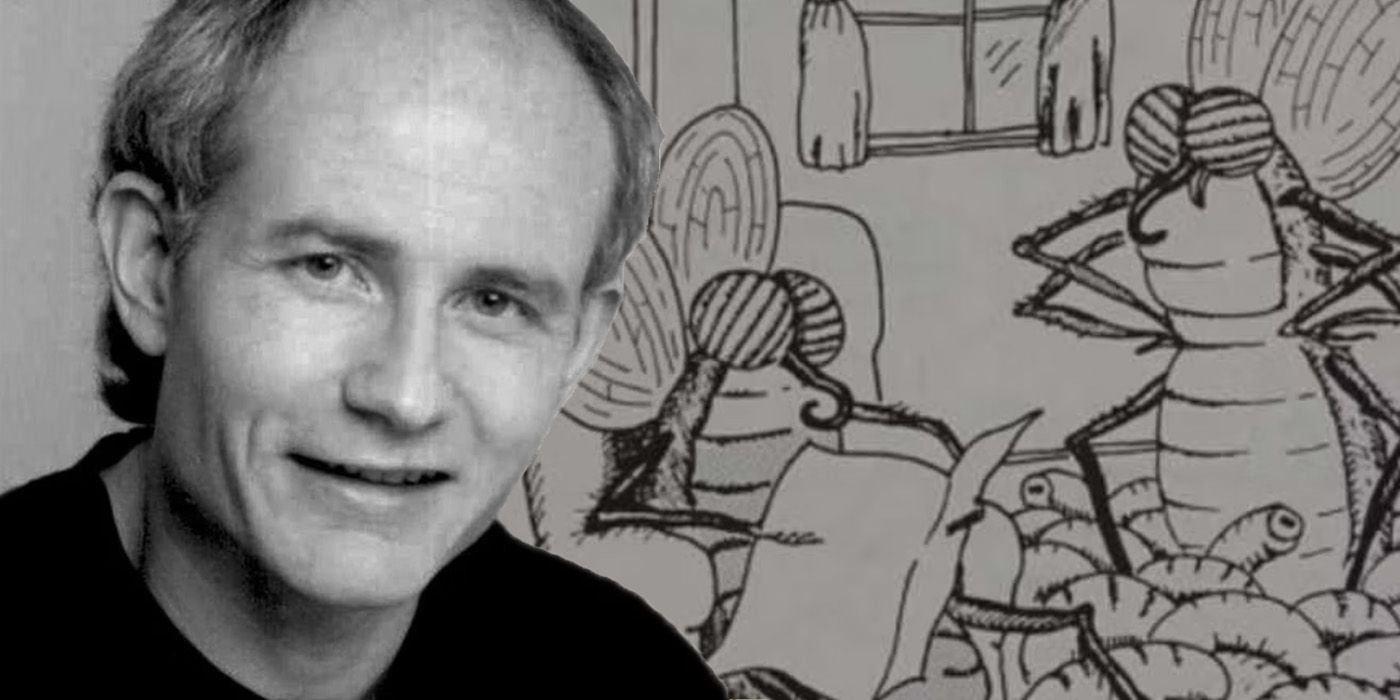Gary Larson's Final Words On His Career Are Bizarre, Touching, & Perfect For The Far Side
Summary Gary Larson's career retrospective, as part of The Complete Far Side, concluded with an emotional, if characteristically strange, essay that started by reflecting on unproduced cartoons and ended with a bizarre comparison between spiders catching bugs & humans catching fish.
Larson's meditation on creative fulfillment led to his connection between how his father felt catching a fish, and how spiders felt catching gnats; in a way, this effectively mapped out the evolution of a Far Side joke for readers, one final time.
Larson's musings offered incredible insight into his artistic process, and his unique brand of humor, in the two-volume The Complete Far Side.
Gary Larson, creator of The Far Side, is by any measurable standard, an idiosyncratic artistic mind, with a singular perspective on his art, and the whole world in general, that no one could truly replicate – something thrown into sharp relief by his final essay in The Complete Far Side, which wrapped up his retrospective on his career.
Near the end of The Complete Far Side Volume Two, Larson penned one final essay, which began with him acknowledging that he occasionally regretted retiring, and ended with him admitting that he wanted "to stop writing about cartoons and thinking about cartoons."
In between, the essay diverged into an increasingly strange, if memorable, comparison between spiders catching insects, and fishers – specifically, Larson's father – catching fish, sparked by the artist's meditation on creative fulfillment, and articulated as only he could.
Related Gary Larson Told Fans Exactly How The Far Side Would End – A Decade Before It Did As far back as a decade before Far Side Creator Gary Larson retired as a cartoonist, he was already telling fans how and why the comic would end.
Gary Larson's Reflection On His Career Ended With An Insight Into His Creative Mind
A Window Into The Far Side's Creation
Though he subsequently takes the comparison to a level of heightened absurdity, in patented Far Side style, at the root of it is a deeply relevant connection between his work as an artist, his father's hobby of fishing, and yes, even spiders catching gnats.
Throughout The Complete Far Side, Gary Larson penned a number of short essays, offering wonderful insights into his creative process, along with anecdotes from throughout his career. The essay that concludes the sprawling two-volume set finds Larson wrestling with contradictory feelings: at once missing his time as a cartoonist, and grateful it is over; melancholy at prolonged exposure to memories of the bygone past, and also anxious to turn his attention back to the present. Ultimately, he retreats into a familiar mode, shifting – so to speak – from thinking in terms of "memoir" to thinking creatively.
In other words, in order to escape his wistful reverie, the author turns his attention to something else that has distracted him – and in the process, offers one further insight into the mind that produced so many Far Side cartoons. As he wrote:
Serendipity has handed me a way to wrap this up. I'm sitting here writing my final essay for this book, and every few minutes I lift my eyes from the computer monitor and stare out the window overlooking the garden. But I'm not looking at the garden. I'm watching the small spiders that have spun webs between the leaded panes and brick frame. There are four of them, and they're catching gnats like they know it's the gnat warden's day off. This is really a show. They're extremely small, these spiders, but the gnats – and they're as thick as, well, gnats – are considerably smaller. There are so many, the spiders aren't even bothering to throw a few holding threads around their prey. They're just grabbing and sucking down gnats, one after the other. I can't help but imagine that somewhere within the primitive, ganglionic mass that serves as a spider's brain, these little guys are experiencing a sensation that equates to what my dad, an avid fisherman, feels when a salmon strikes the line. Hot damn! Another one!
Here, readers are privy to the kind of quick, intuitive connection-making that was foundational to Gary Larson's success as an artist. He finds a connection between spider and human behavior, which in turn offers a strong analogy for his creative endeavors.
At the same time, Larson also exhibits another vital aspect of The Far Side; his humor was so idiosyncratic because it began as deeply personal, yet the end result was so often universally recognizable, and widely applicable. Though he subsequently takes the comparison to a level of heightened absurdity, in patented Far Side style, at the root of it is a deeply relevant connection between his work as an artist, his father's hobby of fishing, and yes, even spiders catching gnats.
Gary Larson On The Parallels Between Spiders And Fishing (& Artists)
Trust Him, It Makes Sense
Close
When he sat down at night to work at the same desk where he later composed this essay – next to the same window where he watched the spiders – illustrating Far Side cartoons was Gary Larson's equivalent of catching gnats, or reeling in a keeper.
The last essay in The Complete Far Side Volume Two is especially endearing for the way that it traces the evolution of Gary Larson's thought process – arriving at a point which has the feeling of a familiar Far Side observation. Larson elaborated on the connection between spiders and his father, in the end arriving at an improbably absurd conclusion:
The parallels are interesting, now that I think about it: My dad's invisible fishing line/the spider's invisible web; my dad's net/the spider's holding threads; my dad sitting alone in his boat, patiently waiting for a strike; the spiders sitting alone in their webs, patiently waiting for the same signal. There's only one conclusion: My dad's really just like a big spider, and all these little spiders are really just like my dad. (All we need now is for one of these little gnats to start screaming "Help me!" and this will get really weird.)
Through every step of this intellectual exercise, Gary Larson exhibits The Far Side's trademark humor, a delightfully skewed approach to the world that has resulted in his work's enduring legacy.
The silliness of the "punchline" here aside, Larson's observation here can be praised for the way it ties back to his reflections on retirement. For him, when he sat down at night to work at the same desk where he later composed this essay – next to the same window where he watched the spiders – illustrating Far Side cartoons was Gary Larson's equivalent of catching gnats, or reeling in a keeper. The essay makes it clear that he missed the tug of creative satisfaction, just not enough to keep drawing The Far Side.
The Far Side Complete Collection $71 $125 Save $54 Fans of the far side can't pass up this master collection of Gary Larson's finest work. Originally published in hardcover in 2003, this paperback set comes complete with a newly designed slipcase that will look great on any shelf. The Complete Far Side contains every Far Side cartoon ever published, which amounts to over 4,000, plus more than 1,100 that have never before appeared in a book and even some made after Larson retired. $71 At Amazon
The Creation Of The Far Side Was All A Distraction To Gary Larson
How He Turned A Short-Attention Span Into A Career
How quickly his mind moved on to the connections between spiders, fishing, and art only served to drive home the fact that he still had an incredible reservoir of ideas and creativity within him – except, barring brief flare-ups, he no longer had the will to produce cartoons.
In a way, it can be said that The Far Side was the product of a cultivated power of distraction, with Gary Larson's creative "superpower" being his ability to turn what is a negative for most artists into a positive. He passingly acknowledged as much in The Complete Far Side Volume Two, drawing his last essay to a close by tenderly, if conspiratorially, confiding in his readers. As Larson wrote:
I'm telling you this because I'm guessing – or hoping – you may know me a little by now. My mind seems to wander. I started off wistfully describing a few cartoons I wish I had drawn, wondering about the ones yet to be imagined, and what happens? – I get cut off by some little spiders.
For Larson, being distracted by the natural world was ultimately a virtue – as exhibited here, it tended to stimulate some of his most exciting, engaging ideas.
As he noted here, the essay began with Gary Larson discussing being "haunted" by the question of "what else didn't [he] draw?" and the thought of unproduced Far Side comics. How quickly his mind moved on to the connections between spiders, fishing, and art only served to drive home the fact that he still had an incredible reservoir of ideas and creativity within him – except, barring brief flare-ups, he no longer had the will to produce cartoons, and really could only stand to engage with them for short bursts of time.
As An Artist, Gary Larson Was "Drawn To The Little Things"
And It Took Him To Big Places
Close
As much as Gary Larson set out to "draw the little things," the scope and the depth of his work, and his worldview, developed considerably over time. Still, he achieved this...by finding humor and appreciation for the world in places that everyone else overlooked.
By the end of the essay, having recovered from his tangent about the spiders, Larson's burst of creative enthusiasm had faded, leaving him with only the slight ache of the reminder of what it was like to produce The Far Side. Yet all of this led up to a heartfelt, concise summation of his career. According to Larson:
Here's where I must simply admit the truth: I want to stop writing about cartoons and thinking about cartoons. I just want to watch these little spiders. This is how I started as a cartoonist – drawn to the little things – and this is how I'll end. And if you run into my dad, please don't squish him.
This full circle moment reads as particularly emotionally charged, and it seems clear that Larson considers it definitive – and weighty enough that he chose instead to end on one final joke about his father being a spider.
Admittedly, as much as Gary Larson set out to "draw the little things," the scope and the depth of his work, and his worldview, developed considerably over time. Still, he achieved this by constantly prioritizing the "little things," and by finding humor and appreciation for the world in places that everyone else overlooked. This was what drew him with equal interest to nature, including insects such as spiders, and inanimate objects, which he imbued with an incredible amount of life.
Related "What Else Didn't I Draw?": Gary Larson On The Far Side Comics Left Unproduced By His Retirement Reflecting on his career several years into retirement, Gary Larson admitted that he fleetingly felt haunted by the Far Side comics he never drew.
Gary Larson's Emotional Send-Off To The Far Side Is The Author At His Best
A Must-Read For Fans
[Gary] Larson's writings in The Complete Far Side are essential for anyone who seeks a more detailed understanding of a generational American creative talent.
Gary Larson's sense of humor is reflected to a strong degree in modern internet humor, yet at the same time no artist has truly been able to capture, or recreate, precisely what distinguished The Far Side from everything else. Larson's digression in his final essay from The Complete Far Side Volume Two is incredibly valuable to artists studying his work for the way that it maps the intrusion of a Far Side-like idea into the normal flow of his mind. For fans of the comic, it is an emotional send-off for the long-running serial.
In any case, though Larson did sporadically return to The Far Side decades after retiring, The Complete Far Side captures him at a moment in time when that seemed unlikely, giving readers a striking insight into the artist's relation to more than just his art, but to his career, and the public perception of him. While readers can come to be familiar with Gary Larson, to a degree, through familiarizing themselves with The Far Side, Larson's writings in The Complete Far Side are essential for anyone who seeks a more detailed understanding of a generational American creative talent.
Source: The Complete Far Side Volume Two











COMMENTS